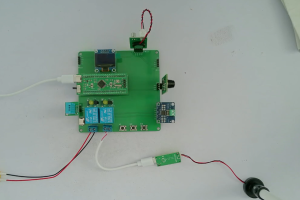设计说明书
总字数:19000+
随着全球能源需求的不断增长和环境问题的日益严峻,智能节能技术在日常生活中的应用变得尤为重要。传统的用电设备大多采用手动控制,不仅操作不便,还容易因人为疏忽导致能源浪费。智能节能用电控制器通过集成多种传感器和自动化控制技术,能够根据环境参数和用户需求自动控制电器设备的运行,实现节能与便捷的双重目标。
本设计基于STM32F103C8T6单片机,通过DHT11传感器检测环境温湿度,自动控制空调和加湿器的开关;利用D203S人体红外传感器检测是否有人,实现用电器的自动启停;通过电压电流检测模块INA219监测电能使用量;结合语音识别模块SU-03T实现语音控制功能;并通过OLED显示屏实时显示环境参数和设备状态。用户还可通过按键设置温湿度阈值和手动控制设备。
该智能节能用电控制器能够有效降低能源消耗,提高用电效率,同时为用户提供便捷的设备控制体验。它适用于家庭、办公室等多种场景,具有显著的节能效果和良好的用户体验,对推动智能节能技术的广泛应用具有重要意义。
关键词:节能技术;单片机;传感器;显示
With the increasing demand of global energy and the increasingly serious environmental problems, the application of intelligent energy-saving technology in daily life has become particularly important. Most traditional electrical equipment is manually controlled, which is not only inconvenient to operate, but also easy to cause energy waste due to human negligence. By integrating a variety of sensors and automatic control technology, the intelligent energy-saving power controller can automatically control the operation of electrical equipment according to environmental parameters and user needs, realizing the dual goal of energy saving and convenience.
This design is based on the STM32F103C8T6 single chip computer, detect the environmental temperature and humidity through the DHT 11 sensor, automatically control the switch of the air conditioner and the humidifier; use the D203S human infrared sensor to detect the automatic start and stop of electrical appliances, realize the monitoring of the power usage through the voltage and current detection module INA219; realize the voice control function combined with the speech recognition module SU-03T; and display the environmental parameters and equipment status in real time through the OLED display. The user can also set the temperature and humidity threshold and manually control the device.
The intelligent energy-saving power controller can effectively reduce energy consumption, improve electricity consumption efficiency, and provide users with convenient equipment control experience. It is suitable for home, office and other scenarios, has significant energy saving effect and good user experience, and is of great significance to promote the wide application of intelligent energy saving technology.
Keywords: energy saving technology; single chip microcontroller; sensor; display
目 录
摘 要
Abstract
1 绪论
1.1 课题研究的背景及意义
1.1.1 课题研究的背景
1.1.2 课题研究的意义
1.2 国内外研究现状
1.2.1 国外研究现状
1.2.2 国内研究现状
1.3 本文研究内容
1.3.1 论文结构
1.3.2 研究方法及手段
2 系统分析
2.1 可行性分析
2.1.1 经济可行性分析
2.1.2 技术可行性分析
2.1.3 操作可行性分析
2.2 需求分析
2.2.1 关键技术
2.2.2 业务流程分析
2.2.3 功能需求分析
2.2.4 性能需求分析
2.2.5 将来可能提出的需求分析
3 系统方案设计
3.1 架构设计
3.2 功能模块设计
3.2.1 主控模块方案选择
3.2.2 温湿度模块方案选择
3.2.3 电压电流检测模块方案选择
3.2.4 语音识别模块方案选择
3.2.5 显示模块方案选择
3.2.6 人体检测模块方案选择
3.2.7继电器模块选择
3.3 硬件设计
3.3.1 功能原理图
3.3.2 单片机最小系统
3.3.3 温湿度模块电路设计
3.3.4 电压电流检测模块电路设计
3.3.5 语音识别模块电路设计
3.3.6 OLED显示模块电路设计
3.3.7 人体检测模块电路设计
3.3.8 继电器模块电路设计
3.3.9 按键电路设计
3.4 软件设计
3.4.1 系统主流程设计
3.4.2 独立按键
3.4.3 OLED显示流程设计
3.4.4 温湿度检测模块子流程设计
3.4.5 电压电流模块子流程设计
3.4.6 语言识别模块子流程设计
3.4.7 人体检测模块子流程设计
4 系统实现
4.1 系统开发环境
4.2 功能模块实现
4.2.1 元器件清单
4.2.2 主程序功能实现
4.2.3 温湿度监测功能实现
4.2.4 电压电流监测功能实现
4.2.5 语音识别功能实现
4.2.6 OLED显示功能实现
4.2.7 人体检测功能实现
5 功能测试
5.1 软件测试
5.2 硬件测试
5.3 联合测试
5.3.1温湿度检测模块测试
5.3.2人体检测模块及用电器控制测试
5.3.3电能检测模块测试
5.3.4语音模块测试
5.4 测试结论
6 总结与展望
6.1 总结
6.2 展望
参考文献
附录一 原理图
附录二:PCB板
附录三:程序
致谢
购买后可查看具体内容!

